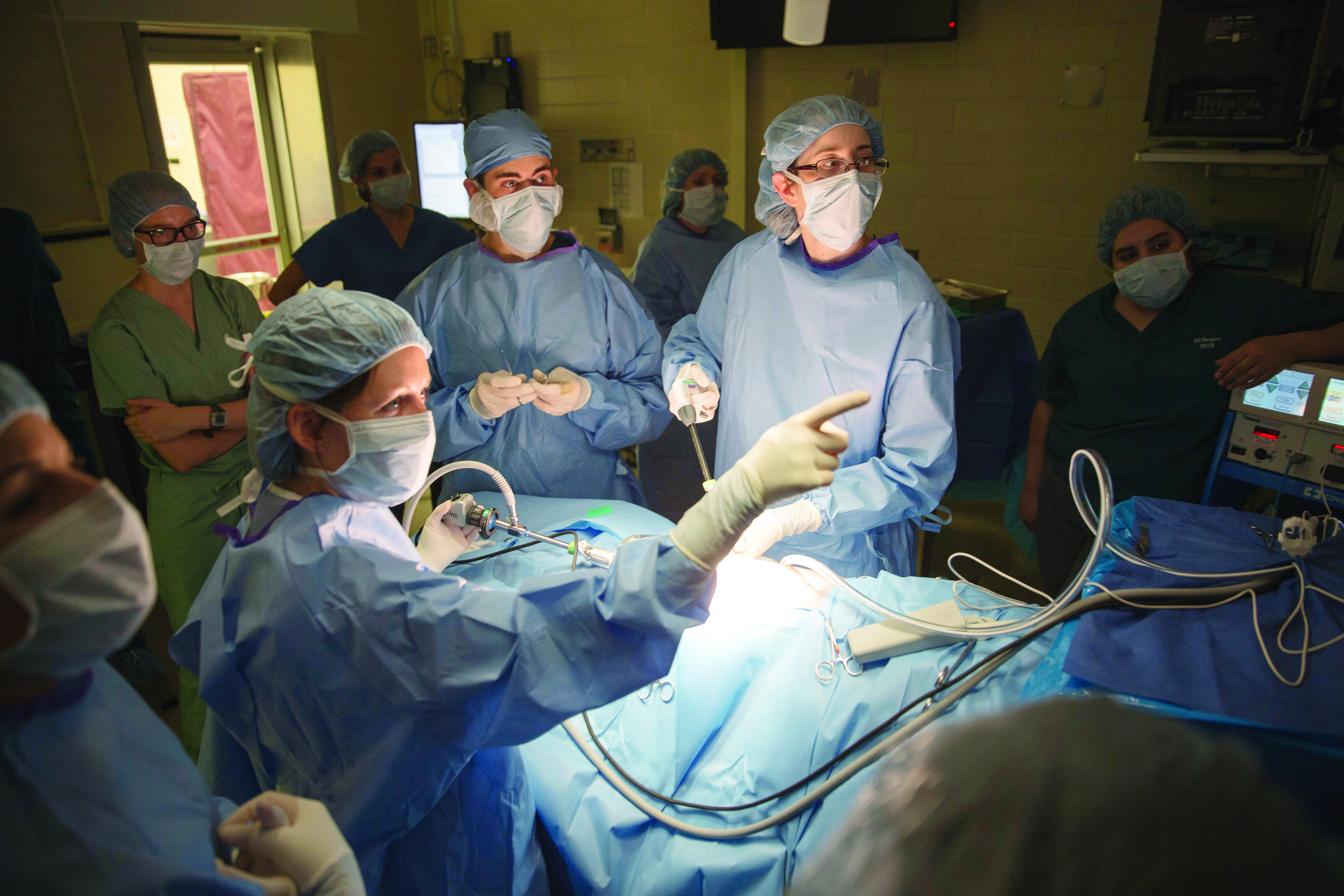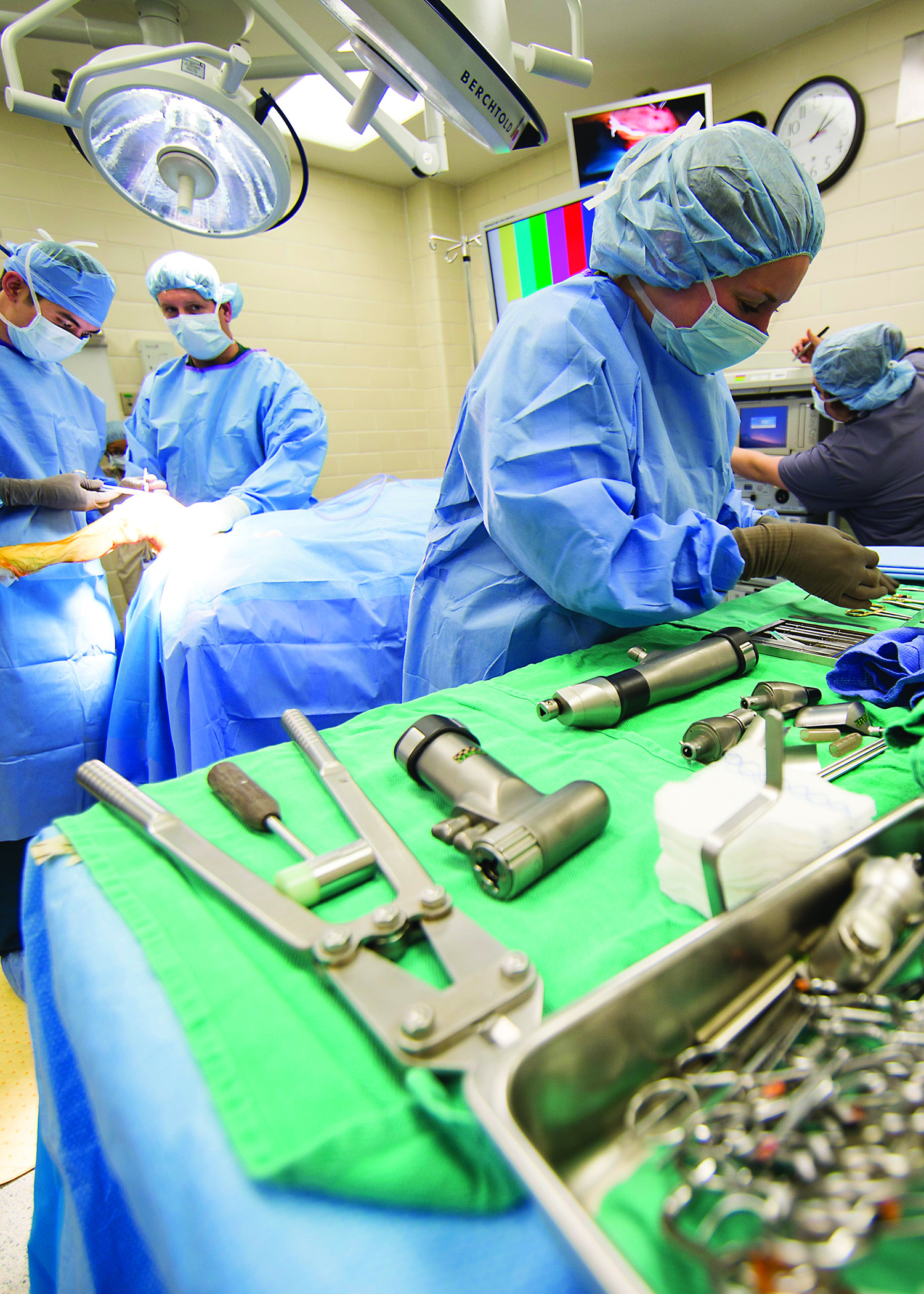Communicating in Surgery
With lives on the line, the ability to communicate during surgery has always been critical. This is even more so the case in a teaching hospital like the one at the Texas A&M College of Veterinary Medicine & Biomedical Sciences (CVM), where highly skilled clinical faculty are joined in the same room by the students.

For both specialists and students, seeing is communicating in the surgical suite, and sight has been transformed by the advent of digital radiography. On top of enhanced audiovisual capabilities, digital radiography has improved the clarity and speed whereby a surgical team and students can readily see the anatomical areas involved in a procedure.
New technology has not only affected communication within the surgical suite, it has enabled communication with consulting clinicians, who could be located anywhere in the world. For students, it means that when there is not enough room in a surgical suite for their active participation on a case, they can view the procedure and the accompanying images in a nearby rounds room or observation room.
Sonya Gordon, a cardiologist and associate professor in VSCS, said that digital radiography has improved workflow overall, including the speed at which clinicians can communicate with each other. “Digital radiography changed everything,” she said. “Being able to look at high-quality images and quickly communicate all of the information to others has been a game changer.”
The CVM is expected to open its new classroom and laboratory complex in 2016 and is concurrently developing plans to build a new small animal hospital. Part of the vision includes a client-friendly lobby and waiting space, but for the clinicians the most exciting part of the new planned facility is the increased space and its impact on communication within surgical teams, with students, and with colleagues.
By creating facilities that will function well into the future, the goal is to create space that will accommodate emerging surgical technologies. This may also lead to changes in how surgery may one day be performed.
Dr. Audrey Cook, associate professor in VSCS, noted many of the advanced procedures performed at the teaching hospital are intensely collaborative and often include using small camera-like devices. The space for collaboration and the ability to instantly share images with others, including students, are what makes the future growth of the hospital so exciting for her.
Jacqueline Davidson, clinical professor in the Department of Small Animal Clinical Sciences (VSCS) agreed and said, “Digital imaging, text messaging, and smartphones have enabled us to send a digital image by phone, text message, or email, and communicate between colleagues who may not be in the room. However, what we’re hoping is to have audiovisual equipment in the room so we can communicate live with someone who’s not in the room, in real time.”
Technology Improves Communication in Surgery
In the surgical suite, there is often a balance between the amount of space required for the surgical team to perform maximally and allowing students to see procedures without obstructions. In present-day surgical suites, such obstructions include new technology and equipment. The latest surgical equipment enhances veterinarians’ ability to operate and allows specialized procedures to be performed. “We have a lot more technology in the room,” said Davidson. “When I was a veterinary student, the equipment was much less sophisticated and didn’t require a lot of extra space in the operating room, as it does today.”
Along with more technology, surgical teams now involve more specialized clinicians, making communication all the more critical. According to Cook, pre-surgical meetings are now essential for every case because they allow surgeons to understand the strengths and expertise of each team member.
“In the past, we tended to do procedures that were much more basic,” said Cook. “These days, we do procedures that are much more complicated. It’s not unusual for us to do a procedure and have an internist, a criticalist, and a surgeon all working at the same time on the same patient. So, I think it’s really important for the teams to be able to communicate before a procedure starts.”
In addition to the increased number of specialists in the surgical suite, teaching hospitals often have more students in the room. Cook and Davidson noted the importance of including students, but said there is not always adequate room for them to observe and learn from the procedures.
“I think right now we’re limited by physical space. The students might be able to watch some of the procedures in their classrooms and rounds rooms, but that’s not nearly as useful as getting them a more profound presence,” Cook said. “In small rooms, the people we send out are usually the students when we’re pressed for space. That’s a loss because they don’t get to be a real participant in the process.”
Taking Things to the Next Level

Envisioning what future surgical suites might look like, Davidson said, “What I look forward to the most is having a room that’s big enough to accommodate all the people that need to be there and to have the audiovisual equipment to communicate beyond our current reach,” she said.
Similarly, Cook imagined a day where other centers and hospitals could collaborate virtually. “If we’re working on a patient on a procedure our team has not done before but another team has, we could live stream our imaging so they could be there with us virtually-That would be priceless. Maybe they’re in the same building but across the hallway, maybe they are hundreds of miles away in a different center. That would really be an invaluable resource for us to have.”
Such futuristic concepts of what surgery may become are the driving forces behind the designs for the new facility. Redesigned surgical space filled with the latest equipment in the hands of skilled clinicians will bring the next level of care to the CVM.
Technology may impact collaboration, communication, and the ability to do increasingly complex procedures, but veterinarians at the CVM point out that the most important aspect of any teaching hospital’s surgical suites is the education of future veterinarians. As planning moves forward, the new surgical space will allow a larger number of team members to participate in a case-especially students.
“A lot of the joy in what we do is in that surgical team coming together and making something work,” said Cook. “The more we can involve the students and communicate our excitement with them, the more they’re going to get out of the whole process.”
Currently, the new small animal hospital is in the design phase. An active fundraising effort is working to secure funding that ensures the new facility fosters technological innovation, collaboration, and improved communication for faculty, staff, and students. And of course, central to all planning will be what is best for the patient.


